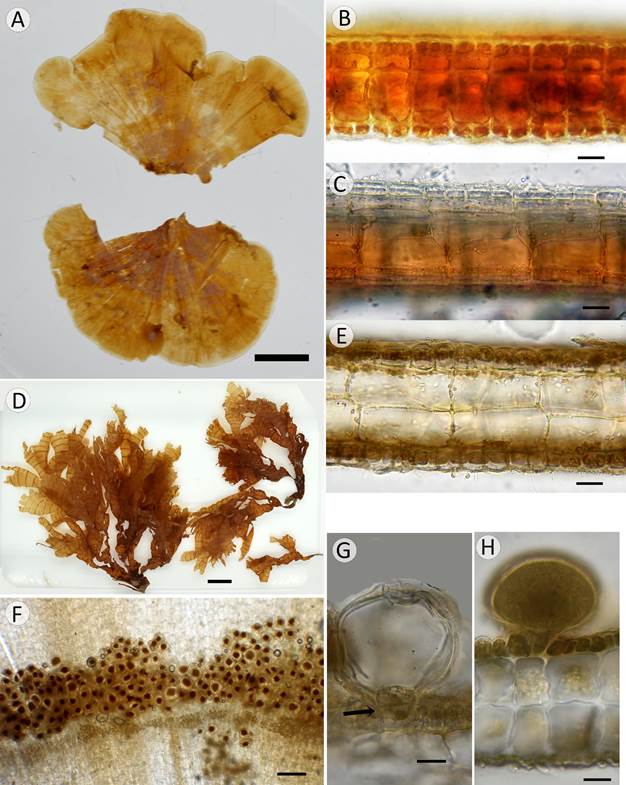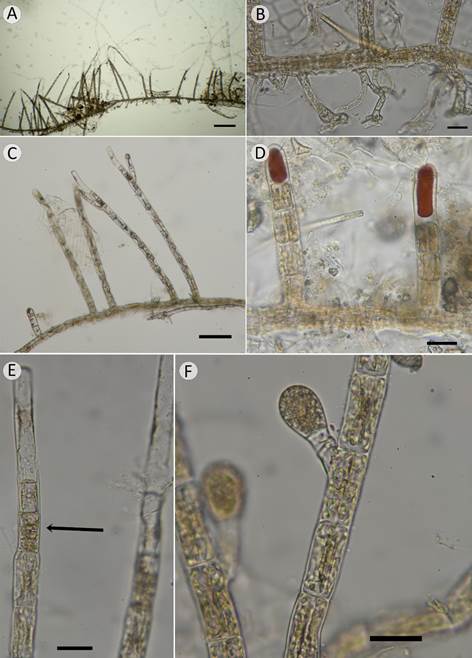Introduction
In tropical environments, brown algae are not very diverse, when compared to other groups of macroalgae (Mateo-Cid et al., 2019). The order Dictyotales is the exception to the rule because its diversity is greatest in tropical and warm temperate waters (Vieira et al. 2017). They are very conspicuous members of benthic communities, and aggressive competitors of corals for substrate (Vieira et al., 2019; Ramseyer et al., 2021), due to their fast growth, dispersal through fragmentation (Herren et al., 2006), as well as the production of secondary metabolites deterring herbivory (Vieira et al., 2019). In the past decade, molecular-assisted research has revealed a great diversity of members of the order, specifically for the genera Dictyota J.V. Lamouroux (Tronholm et al., 2013) and Lobophora J. Agardh (e.g., Schultz et al., 2015; Vieira et al., 2020) in the great Caribbean Sea. It is probable that in the near future several other species will be newly described, as many members of these genera are still a complex of species. Most of the described new species to date are morphological distinct, which eases the identification in the laboratory when molecular analyses are not feasible.
During the Scientific Expedition Seaflower 2019, macroalgal collection was undertaken at different depths and environments, around the islands of Old Providence and Santa Catalina, in the southwestern Caribbean Sea. We present here three new records of brown algae for Colombia: Lobophora declerckii N.E. Schultz, C.W. Schneider & L. Le Gall, Taonia abbottiana D.S. Littler & Littler and Verosphacela ebrachia E.C. Henry. All the morphological features of the species reported here are illustrated and discussed.
Materials and Methods
Sampling was undertaken around the islands of Old Providence and Santa Catalina, which are part of the International Biosphere Reserve Seaflower, located in the southwestern Caribbean, Colombia (Fig. 1). The expedition took place in September 2019, where sampling was carried out in a depth range of 3-16 m. Most sites were coral reef patches or sand plains, with some seagrass beds at depth ranges of 6-8.5 m.
Algae were collected by hand during SCUBA diving. The algae collected were preserved in a 4% formalin/seawater solution and kept cool until their identification. The identification was carried out using a binocular stereoscope Zeiss Stemi DV4 (Jena, Germany) and an optical microscope Olympus BX51 (Tokyo, Japan) connected to a digital camera Moticam 2300 3.0M pixel (Hong Kong, China). Cross-sections of the specimens were made by hand with a razor blade. Images were edited using Adobe Photoshop CS6 v. 13.0 (Adobe, 2012). To identify the species specialized literature was used (e.g., Dawes and Mathieson, 2008; Schultz et al., 2015). The specimens were deposited in the Herbarium JIWUKORI (JIW) of the Universidad Nacional de Colombia, in Bogotá. Information on nomenclature and taxonomy classification was obtained from AlgaeBase (Guiry and Guiry, 2023).
Results
We here report for the first time the taxa Lobophora declerckii, Taonia abbottiana and Verosphacela ebrachia for Colombia.
Dictyotaceae
Lobophora declerckii N.E. Schultz, C.W. Schneider & L. Le Gall, Eur. J. Phycol. 50(4): 481-500. 2015.
TYPE: GUADELOUPE. Tombant de Port-Louis, 29 m, 16°23'44.34''N, 61°32'4.318''W, 15.V.2012, L. Le Gall et al. (holotype: FRA1676).
Thallus decumbent, fan-shaped, brown in color, with rhizoids on the ventral side of the blade; blades 4-5 cm wide and 2-3 cm tall, lobate, with entire margins (Fig. 2A); thallus 98-102 µm thick; alga composed by 3-4 cell layers: one medullary layer, two dorsal cortical layers and one ventral cortical layer (Fig. 2B, C); medullary cells 48-54 µm tall, 76-83 µm long, 37-39 µm wide (Figs. 2B, C); the outer dorsal cortical layer composed by cells 10-11 µm tall, 13-39 µm long, 13-18 um wide (Figs. 2B, C); in transverse section (Fig. 2B) 2-3 outer cortical cells, covering the width of one medullary cell on the dorsal side; in the subcortical layer, only one cell covers the width of a medullary cell; on the ventral side, 1-2 cortical cells cover the width of the medullary cells; in longitudinal section (Fig. 2C), 2-4 cortical cells on the dorsal side cover a medullary cell, while on the ventral side one cell covers the length of a medullary cell; reproductive structures not observed.

Figure 2: A-C. Lobophora declerckii N.E. Schultz, C.W. Schneider & L. Le Gall. A. habit; B. transverse section; C. longitudinal section; D-G. Taonia abbottiana D.S. Littler & Littler. D. habit; E. transverse section; F. surface view of sporangial sori; G. transverse section showing pedicellate sporangia (arrow); H. Stypopodium zonale (J. V. Lamouroux) Papenfuss. Cross section showing sporangium without pedicel. Scale bars: A=1 cm, B, C, E, G, H=25 µm, D=2 cm, F=250 µm.
Notes: the genus Lobophora (Dictyotaceae) has suffered a large rearrangement in the past decade, with the description of a great number of taxa in all oceans (Camacho et al., 2019). Most species have unique morphological features, which is of great help when molecular analyses cannot be performed. In the Western Atlantic, we went from one reported species, Lobophora variegata (J.V. Lamouroux) Womersley ex E.C. Oliveira to eighteen species in the latest checklist (Wynne, 2022). Lobophora declerckii was described by Schultz et al. (2015) to accommodate specimens with large decumbent blades, thin thallus, few cell layers and the presence of 2-3 cells dorsally and 1-2 cells ventrally over each medullary cell in transverse section. Our specimens differ from the type description in the thallus thickness, with 98-102 µm vs. 55-85 µm as described by Schultz et al. (2015). Furthermore, the authors reported strictly five cell layers in the thallus, while we found mostly four cell layers. More recently, Godínez-Ortega et al. (2018) reported the species along the Caribbean coast of Mexico, based on both molecular and morphological analyses. Their specimens of L. declerckii had a cox3 sequence identical to the holotype material, and a morphology very similar to our specimen in terms of thallus thickness, number of cell layers, and overall morphology. The authors found specimens with a thallus 70-110 µm thick, 4-5 layers of cells and lighter brown in color compared to the holotype material. Our specimens match in all the characters those described by Godínez-Ortega et al. (2018). Likewise, the habitat where the species was found matches the one described for it, which is in waters deeper than 10 m. Our specimens were collected at 13 m depth in a reef patches habitat.
Additional material examined: COLOMBIA. Old Providence, Station 20, depth 13 m, 13°23'33.7''N, 81°22'52.3''W, 15.IX.2019, B. Gavio CMD248 (JIW); Station 10, depth 13 m, 13°22'09.5''N, 81°24'30.0''W, Old Providence, 12.IX.2019, B. Gavio CMD112 (JIW), CMD196 (JIW).
Taonia abbottiana D.S. Littler & Littler, Cryptogamie, Algologie 25(4): 419-427. 2004.
TYPE: JAMAICA, two miles west of Discovery Bay, 10-20 m, 18°29.071'N, 77°30.154'W, 2.V.1996, D.S. Littler et al. (holotype: US Alg. Coll. 208962).
Thallus large, 7-15 cm tall, 8-13 cm wide, erect, light to dark brown, fan-shaped with a divided blade (Fig. 2D) concentric line of phaeophycean hairs, attached to the substrate in a single point by a discoid base; thallus 165-205 µm thick, formed by four cell layers, two medullary layers and one cortical layer on each side (Fig. 2E); medullary cells 38 µm high, 83-98 µm wide in transverse section; cortical cells 24-29 µm high, 12-24 µm wide, each medullary cell covered by four cortical cells; sporangia in sori forming horizontal lines above the hair lines (Fig. 2F), round, 100 µm diameter, 86 µm tall, with a two-celled pedicel at the base (Fig. 2G).
Notes: the species was originally described by Littler and Littler (2004) based on specimens from Jamaica. The authors mention that this species is easily confused with Stypopodium zonale (J.V. Lamouroux) Papenfuss. The main character distinguishing the two species are the pedicellate sporangia in Taonia abbottiana vs. the sessile sporangia in Stypopodium zonale. Our specimen was fertile and had pedicellate sporangia (Fig. 2G) compared to those of Stypopodium zonale (Fig. 2H). This species is possibly much more widespread, but easily confused with S. zonale.
Additional material examined: COLOMBIA. Old Providence, Station 7, depth 14 m, 13°24'41.6''N, 81°19'20.5''W, 11.IX.2019, B. Gavio PAFM075 (JIW).
Sphacelariales
Onslowiaceae
Verosphacela ebrachia E.C. Henry, Phycologia 26: 182-191. 1987.
TYPE: UNITED STATES OF AMERICA. Florida, Vero beach, no collection information (holotype: NFLD No. 28091).
Thallus small, epiphytic on Lobophora, with heterotrichous thallus (Fig. 3A); prostrate axes biseriate, 20 µm diameter, from which multicellular branched rhizoids arise (Fig. 3B), up to 75 µm long, 20 µm diameter, sometimes with attachment pad; erect axes uni-or biseriate, to 600 µm high, 20 µm diameter, seldom branched (Fig. 3C), with a unique large apical cell, which may be much darker in color than the rest of the thallus (Fig. 3D); sometimes the apex of the erect filament topped by large phaeophycean hairs, up to 400 µm long; when phaeophycean hairs are present, there is a trichotallic meristem at the base of the hair (Fig. 3E); sporangia on prostrate or erect branches 22 µm diameter, 25 µm long (Fig. 3F).

Figure 3: A-F. Verosphacela ebrachia Henry A. habit; B. branched rhizoids; C. branched erect filaments; D. pigmented apical cells of erect branches; E. trichothallic meristem (arrow); F. pedicellate sporangia. Scale bars: A=250 µm, B=100 µm, C-F=25 µm.
Notes: this small alga was found as epiphyte on Lobophora J. Agardh. It fits the original description by Henry (1987), who described it from the Atlantic coast of Florida. To date, it has only been reported from the type locality and from Isla Mujeres, Yucatán, Mexico (Mateo-Cid et al., 2002). This species is possibly much more widely distributed, as it is easily overlooked due to its very small size and cryptic habit. To date, it has been found only as an endophyte of brown algae of the order Dictyotales.
Additional material examined: COLOMBIA. Old Providence, Station 4, depth 12m, 13°35'25.1''N, 81°20'07.2''W, 10.IX.2019, B. Gavio VH050 (JIW). Old Providence, Station 1, depth 6m, 13°23'52.1''N, 81°23'46.9''W, 9.IX.2019, B. Gavio PAFM 217 (JIW).
Discussion
Lobophora declerckii seems to be the most common species of Lobophora in the Archipelago of San Andres, Old Providence and Santa Catalina. Its thin, large, decumbent thallus may cover a great percentage of hard substrate in coral reef environments, and directly compete with coral colonies (Vieira et al., 2019). As many other members of the Dictyotaceae, the genus Lobophora produces a great variety of secondary metabolites, which may cause bleaching in coral members of the genus Acropora Oken 1815 (Vieira et al., 2016). Due to the recent understanding of Lobophora diversity, we still do not know, at least in the Caribbean Sea, whether different species of the genus harbor different secondary metabolites and if there are species-specific interactions among Lobophora taxa and scleractinian corals. As at other locations in the Caribbean, e.g., Belize (McClanahan et al., 1999) and Curaçao (Ruyter van Steveninck and Bak, 1986), many coral environments in the Archipelago are actually dominated by brown algae of the order Dictyotales. A better understanding of specific metabolic defense of the dominant taxa would give us better cues about interactions among algae, corals and herbivores. The same is true for Stypopodium zonale: this taxon has shown intraspecific variation in its chemical composition (Pereira et al., 2004; Soares et al., 2015). However, secondary metabolite characterization is generally not carried out by macroalgal taxonomists, and the superficial resemblance of Taonia abbottiana with Stypopodium zonale may confuse taxonomists as well. Therefore, it is possible that the metabolic intraspecific variation reported for Stypopodium J. Agardh hides an identification confusion of morphologically similar samples. It would be interesting to determine the metabolic composition of Taonia J. Agardh and compare it with that of Stypopodium. The species Taonia abbottiana is probably much more widely distributed in the Caribbean Sea than actually reported. The same might be true for Verosphacela ebrachia, which, to date, has been reported only along the Caribbean coast of Mexico (Mateo-Cid et al., 2002) after its original description (Henry, 1987). Its cryptic habit and small size go easily undetected.











 nova página do texto(beta)
nova página do texto(beta)




